Familial pain: Harringtons press police for controversial DNA test
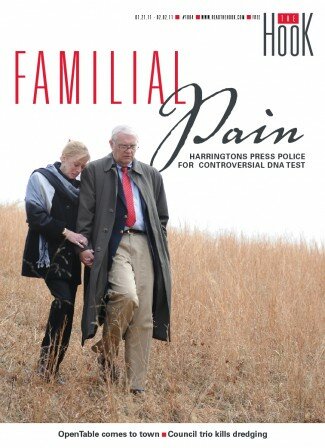 Dan and Gil Harrington visit the secluded spot on Anchorage Farm where their daughter Morgan’s remains were discovered one year ago.
Dan and Gil Harrington visit the secluded spot on Anchorage Farm where their daughter Morgan’s remains were discovered one year ago.PHOTO BY JEN FARIELLO
Dry grass snaps underfoot as Gil and Dan Harrington make their way across the winter-yellowed fields of Anchorage Farm, where one year ago a farmer checking fences discovered the badly decomposed remains of their daughter, Morgan Harrington. The discovery brought a tragic end to a three-month search for the 20-year-old blond beauty, who disappeared after leaving a Metallica concert at the John Paul Jones Arena.
“This is not evil land,” says the bereaved mother, kneeling on the spot her daughter’s body lay and touching the earth. “But there was an evil man or men here who killed my daughter.”
Joined by a clutch of reporters, the parents undertook their first visit to the field, and on the walk down to the site, the 53-year-old mother clutched the arm of her husband, Dan, and cried softly amid the rolling hills nine miles south of Charlottesville.
Gil Harrington’s outpouring of emotion stands in sharp contrast to the stoic frustration she expressed both in the early days of her ordeal and again in recent months as she has learned of a powerful new tool that could assist the investigation.
With police expressing their own frustration at finding a suspect, Gil Harrington has begun speaking out about the tool, which recently helped California investigators nab an alleged serial killer. It hasn’t yet been used in her daughter’s case— not because there’s any law preventing it, but because there’s no policy regarding it at all.
“That,” says Harrington, “is not an acceptable delay to use technology.”
The tool she’s talking about is familial DNA searching, a process by which an unidentified DNA profile— like the one investigators have obtained in the Harrington case, which linked it to an unsolved 2005 Fairfax rape— is run through the state’s DNA databank looking not for an exact match but for a close match that would identify a family member of an unidentified perpetrator and could point in the direction of potential suspects.
The method went high profile last summer with California’s so called “Grim Sleeper” case, and now law enforcement officials across the country are wondering if some of their own toughest cases might be cracked with familial DNA.
The ‘Grim Sleeper’
Beginning in 1985, Los Angeles detectives were stumped by a series of murders of women, many of them prostitutes, whose bodies were found in alleyways on the city’s southside. After a series of exposés by the L.A. Weekly in 2007, including an interview with the killer’s only known surviving victim, police feeling the heat of public pressure ran DNA of the unidentified perpetrator (dubbed the Grim Sleeper because of an apparent 14-year hiatus in killings) through the California DNA database looking for a familial connection. After linking the killer’s DNA to DNA taken from a man convicted on a felony weapons charge— a man who turned out to be the killer’s son– police homed in on 57-year-old Lonnie David Franklin Jr., and believed they’d found the killer. Franklin was arrested in July 2010 and has pleaded not guilty to 10 murder charges.
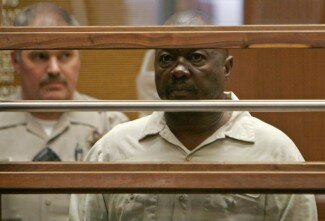 Lonnie David Franklin Jr., accused as the “Grim Sleeper,” was caught with familial DNA.
Lonnie David Franklin Jr., accused as the “Grim Sleeper,” was caught with familial DNA.PHOTO BY REUTERS
Only one state besides California— Colorado— currently uses familial DNA searching, but Virginia, a leader in the forensic use of DNA and the first state to fully fund its DNA databank in the mid-1990s, may soon follow suit, according to Gail Jaspen, chief deputy director of the Virginia Department of Forensic Science. In fact, she says, both the Attorney General’s office and the Virginia Crime Commission have ruled that there’s no legal obstacle preventing the state crime lab from conducting such searches and releasing results to law enforcement. The reason it hasn’t already begun, she says, is that Virginia simply didn’t have the necessary technology.
“We are indeed interested in acquiring the capability to do this as expeditiously as possible,” says Jaspen.
That would be welcome news to the Harringtons, for whom the idea that any stone has been left unturned in the search for their daughter’s killer is source of pain and fear— fear that another woman will be killed by the same man, and another family forced to endure the agony they’re suffering.
“It seems like it’s getting harder now, perhaps because that protective cloaking of shock is dissipating,” says Gil Harrington. “It’s more apparent that she’s not here, her closet doesn’t smell like her anymore, we’re starting to forget what her voice was like.”
No named suspects
The Morgan Harrington case began October 17, 2009 when a disoriented Harrington left the concert alone and began hitchhiking on the Copeley Road Bridge. During the recent media tour, the lead investigator, State Police Agent Dino Cappuzzo, told reporters that a bloodhound and eyewitness accounts confirm the area around the bridge as the last place the Virginia Tech student was spotted alive.
The case has stumped investigators, and a series of revelations over the past 12 months— starting with the discovery of Morgan’s body— have provided evidence to work with but yielded no named suspects. Perhaps the most significant revelation came in July, when investigators confirmed that forensic evidence— later confirmed to be DNA— had linked Morgan’s case to a 2005 unsolved brutal rape in Fairfax. A sketch of the suspect in the Fairfax case generated dozens of new leads, but none have led to an arrest. If Morgan’s killer has a parent, sibling, or child who’s been convicted of a felony since the Virginia DNA databank was launched in 1989, her parents say, there’s a chance a familial DNA search could narrow the potential field of suspects in her case down from countless thousands to a few dozen.
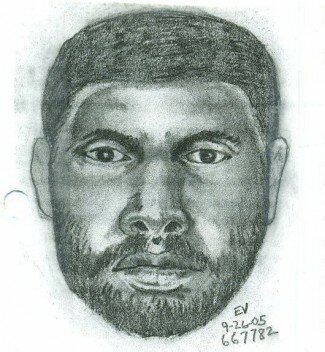 Investigators say DNA evidence links this unknown man, responsible for a 2005 rape in Fairfax, to the Morgan Harrington case.
Investigators say DNA evidence links this unknown man, responsible for a 2005 rape in Fairfax, to the Morgan Harrington case.FAIRFAX POLICE SKETCH
The Harringtons aren’t the only ones eager to see familial DNA searching become a standard weapon in Virginia law enforcement’s crime-fighting arsenal— particularly in violent crimes where a predator remains on the loose.
“A lot of times when you have a convicted felon, you’ll find other felons in the family,” says Albemarle County Sheriff Chip Harding, who pushed for and helped win legislation to fully fund Virginia’s DNA databank back in the mid- ’90s after learning that 150,000 DNA samples had been collected from felons but hadn’t been entered into the databank.
Thanks to that funding, as of December 31, the Virginia DNA databank holds neary 328,000 DNA samples taken from convicted felons and those arrested for violent crimes. By the end of last year, says Harding, law enforcement officials had had 6,957 “hits”— when DNA evidence taken from a crime scene matched a DNA profile in the databank, in many cases leading to a conviction.
Harding recalls one local case that highlighted the critical importance of the databank in solving crimes. In 1999, a man broke into a UVA student’s apartment and raped her while holding her boyfriend at gunpoint. The police had no suspects, just some saliva on a beer can.
Because of a backlog of cases, it took a month for the state crime lab to finally process the DNA. And then came the “cold hit,” an event Harding calls “my most exciting moment in law enforcement.” The DNA from the apartment pointed to a man named Montaret Davis as responsible for the assault and paved the way to a conviction.
The validation process
In late December– after lobbying by the Harringtons— the state came one step closer to making familial DNA searches a reality as the Department of Forensic Science received and installed the familial DNA searching software used in Denver crime labs. Currently, says Jaspen, the software is going through a validation process to “ensure that it does what it’s purported to do and that our people are qualified to perform the searches.”
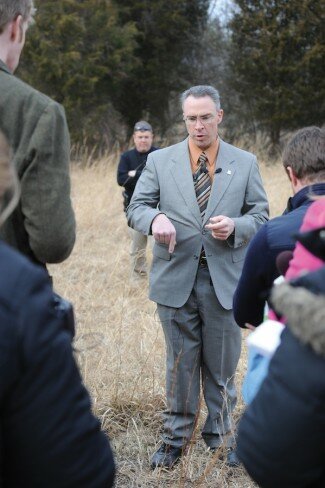 State police Special Agent Dino Cappuzzo, the lead investigator, points to the spot where Harrington’s remains were found.
State police Special Agent Dino Cappuzzo, the lead investigator, points to the spot where Harrington’s remains were found.PHOTO BY JEN FARIELLO
But installing software and actually using it are two different things– particularly in the Harrington case, according to State Police spokesperson Corinne Geller, who says investigators must proceed cautiously with any further DNA testing because the “amount of the evidence available is limited.” (DNA evidence is destroyed when it is tested.)
Limited DNA samples aren’t the only potential stumbling block for investigators. The use of familial DNA searches has already attracted the attention of the ACLU, which filed a legal challenge against California’s policy of collecting DNA from arrestees (as opposed to only from convicted felons).
A July 15 editorial posted on the ACLU of Southern California’s website explains the concerns about familial DNA testing.
“Whether we should expand familial searching isn’t just about the success in this case,” the editorial states in the wake of the Grim Sleeper arrest. “It’s about whether familial DNA searching is really the silver bullet prosecutors suggest, and whether privacy and civil rights concerns have been adequately addressed. The answer to both questions, for the moment, is no.”
And any use of familial DNA here in Virginia will receive similar scrutiny, says Kent Willis, head of the Virginia ACLU, who sees DNA profiling of any kind– particularly of those arrested but not convicted of a crime– as a possible slippery slope.
“First it was just convicted felons, then they moved to anyone arrested for a violent felony,” he says of Virginia’s DNA collecting policies. “We’re concerned that what may happen with familial DNA testing is that once you’ve started the process, unless you create strict protocols, that its use will continue to be expanded and expanded.” For instance, he says, “there are always calls to expand [DNA collection] to anyone arrested for felony or misdemeanor. The ultimate extension is that we should take everyone’s DNA at birth.”
Harding, however, scoffs at the notion that the system would be abused, and says he believes concerns about privacy issues with DNA are overblown— and that old school investigative practices are actually far more invasive.
“I’d argue that intrusion was at its greatest in the old days, the late 70s, early 80s, when there was no such thing as DNA,” he says. Harding, who worked for the Charlottesville Police Department for three decades before his 2007 election to sheriff, recalls following up on tips by digging into the alibis of anyone whose name came up in the course of the investigation— in some cases, hundreds of people.
By contrast, he says, “If I get a list with five or six names on it from a familial DNA search– if one is extremely close, it’s a really good lead– all I’m seeing is who in the family tree might meet the profile, then I put them under surveillance and take a sample.”
“Taking a sample” helped Charlottesville police finally catch the Charlottesville serial rapist back in 2007. After one of Nathan Antonio Washington’s victims recognized the butcher at the Barracks Road Harris Teeter as the man who’d brutalized her, police followed Washington and plucked from the trash a Burger King soda cup he’d just discarded. DNA on the straw matched the profile of the assailant who’d eluded police for nearly a decade. Washington was arrested and is currently serving four life sentences.
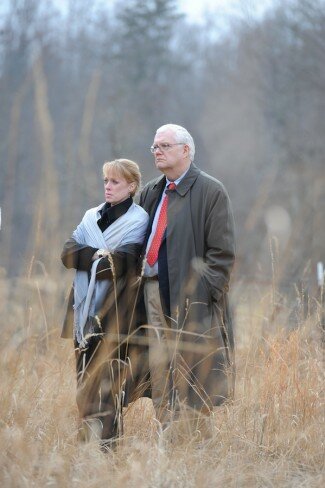 “It’s striking to me how isolated this is,” said Dan Harrington, surveying the secluded field where his daughter’s body was found. Harrington agrees with investigators’ longheld assertion that the person or people who took Morgan to Anchorage Farm know the property well and very likely remain living nearby.
“It’s striking to me how isolated this is,” said Dan Harrington, surveying the secluded field where his daughter’s body was found. Harrington agrees with investigators’ longheld assertion that the person or people who took Morgan to Anchorage Farm know the property well and very likely remain living nearby.PHOTO BY JEN FARIELLO
The ACLU’s Willis says the capture of violent criminals like Washington– and DNA’s proven ability to exonerate the wrongly convicted– make objecting to its use in criminal matters complicated. But he hopes the state will proceed with caution.
“What we want to see come out of the Virginia Crime Commission is a proposed bill that would prevent police from implementing familial DNA and would instead create a study to determine its cost, efficacy, and consider potential invasions of privacy and its impact on fairness in criminal justice system,” says Willis, stressing that the ACLU is “not opposing familial DNA testing; just arguing that the state ought to move slowly into this and know exactly what it’s doing and what the consequences might be.”
The Harringtons, however, say moving slowly when their daughter’s killer remains at large is “crazy.”
“It’s a tool and a technology that exists, and it should be in the hands of law enforcement in this state,” says Gil Harrington. “I don’t know why it would require such prodigious time.”
Correction: Special Agent Dino Cappuzzo’s last name is misspelled in the print edition of this story.–ed





That first sentence/paragraph is just screaming for a competent editor.
Morgan’s murderer (and losers like him) have NO right to protection from the ACLU. We need to find him NOW. He will do this again. Protect us, find him now.
@meanwhile: You’re right. Thanks. I’ve added the missing punctuation. Hope the first sentence didn’t stop you from reading the article.– Courteney Stuart
@meanwhile: did you forget to take your nap today?
Courteney, I did read the article. Well done!
Austro, I wish I could take a nap every day…..
Carolina, I think you’re confusing the rights of the guilty with the rights of the innocent. Every person that has DNA collected from them EXCEPT the perpetrator is innocent of this crime. Those are the people the ACLU is seeking to protect.
I have no interest in ever giving my DNA for any law enforcement database. Nor do I want my children to do so. This is despite the fact that I have nothing to hide, am not wanted for any crimes, nor do I have any plans for criminal activity. If such testing were ever required, I’d be very happy to have the ACLU protest this policy.
On the other hand, I don’t see what’s wrong with implementing familial testing of existing DNA samples. Familial DNA would, it seems to me, be just one more piece of evidence, not unlike the physical description of a perpetrator. Harding’s opinion on this subject seems germane.
They should implement this technology as soon as possible. Unfortunately, the major reason why law enforcement doesn’t or won’t implement new investigative technologies is lack of funding.
Courteney, keep up the good work. You are GREAT at what you do.
I have only a tiny fraction of the sorrow of the Harrington’s and it is almost too much to bear.
I appreciate your work.
@meanwhile would you like to show us how you might construct that paragraph? Maybe you could entertain us with one of your published works?
This article is an example of Courteney’s excellent reporting; not only does she get the big picture, she is sensitive to the subject, and impartial where it counts. Keep the fire burning because we need someone like you.
This is a heart breaking situation. I’d like to have seen more info come out about the case. I hope that LE has a suspect or suspects.
I admire this couple’s strength where such deep sorrow has not stopped them from pursuing this case.
It seems to me the ACLU is always a bit to happy to always want to prevent something. They file suit for this and that just to get their name in the headlines. I have gotten to the point where I’m sick of seeing their name on every major headline they can creep into.
I would like to hear all the details with regard to the UVA basketball players contact with Morgan that night. Has that come out or has UVA, being the 500 LB gorilla, been able to keep that quiet? Was her shirt found near student athlete housing? The key to her death is the list of whom has been on that farm in the past or who lives nearby with knowledge of the area. Why haven’t the Harrington’s sued over the policy of not allowing someone back in the facility which directly led to their daughter’s death if for no other reason than to expose how stupid this policy is?
I cannot even image what the Harringtons are going through but admire their devotion to their daughter and staying the course. Without their constant vigil toward authorities, I could see this case slipping into that black hole that swallows crimes as so many new ones come in and the resources to fully investigate and gather evidence dwindles with the poor economy. Stay strong, they will find the answer. I just hope they do before this person(s) strike again.
Sounds to me like they are getting close to solving this horrible crime. Unfortunately he may have already killed again.
@courtney - handled the criticism as positive and with your usual professional attitude! :) Keep up the good work!
Something that bothered me about the body being crushed (don’t think it was mentioned in this article, but it was mentioned in previous articles) was that I didn’t see anybody theorizing about the possibility that the body was run over? What else would cause bones to be crushed like that?
Something that bothered me about the body being crushed (don’t think it was mentioned in this article, but it was mentioned in previous articles) was that I didn’t see anybody theorizing about the possibility that the body was run over?
***
Plenty of people on this board theorized about this. But I don’t think that the body was ever described by the coroner as “crushed.” Instead, bones were shattered. The implication of the coroner’s report, at least as it was reported, was that the pattern of broken bones was consistent with physical assault.
Please stop harping on the arena’s policy on not readmitting people who leave the facility. It is their policy. It’s made clear that you can’t go in and out. They have the right to set their policies. If you don’t like the policy don’t buy tickets for events at the JPJ.
I’m surprised the Harringtons are not using some of their press time to encourage young women not to engage in risky behavior. It is well known that Morgan was not in a clear frame of mind when these events occurred. She made some really poor decisions. I don’t blame her or her parents or her friends or the arena staff or the random people who came into contact with her before she disappeared for what happened to her. There were lots of opportunities for things to turn out differently. Some evil person entered the picture and she was vulnerable. So I will say here what I am hoping the Harringtons will say over and over again: please, young women who are reading this, take care of yourselves. The world is not as safe as your might assume. Keep your senses and your friends with you. You might need them. I pray the police will capture whoever did this. I know they are using every tool they have right now.
What I can’t help but wonder is if the FBI in VA has the capibility to test familial DNA. (I’d imagine they do) If so I’d like to know again why VSP isn’t asking for their assistance? If the primary reasoning at this point is that the technology isn’t available to the state police..
rick, I’m sure you’re able to follow the fact that Courteney edited the sentence after my comment? Perhaps you made your comment before you read Courteney’s. I’ll assume that that’s the case.
Courtney-
great article. So in short, they’re installing the software, training ppl to use it, they have a limited amount of dna evidence to test and since dna testing destroys the evidence, they cant run multiple tests. And also if theyre going to try this case in VA then they have to have a statute saying it’s something that can be used as admissable (sp?) evidence.
I am wondering if the FBI already has this technology and also statutes the prosecute on. I know this isnt a federal crime, but since the FBI can join an investigation if reqested to by LE…I wonder if they could try it in Fed court.
Basically…I just want the tests to take place before he strikes again. I wonder why they arent working with the FBI.
J4M
I am so thankful that the Harrington’s continue to press for the capture of their daughters murderer. It is heartening to notice through their words and actions that it is also because of their concern for others that may be future victims of this very sick person that they press so hard.
There’s nothing wrong with the first sentence, or paragraph Bud. Courtney is a top rate journalist and if you think you can do better, go find a position and show us.
As to this tragedy-it seems like it has gone on for 5 years vs. this 1 and a half year. I fear that Gil will never recover at this point. She seems so bereft and overwhelmed, poor woman. I read a half year ago her saying similar things about feeling she is losing the memories of her daughter. It must be terrifying to be in that position. I can only hope she is reaching out to other families that have gone through losing a child through violence and finding a mentor or support system to lean on. It seems they seek solace from the public which will continue to wane over time so a more permanent support would perhaps be helpful for them both. Being health care professionals may make it harder for them to seek help, but I do hope those close to the Harringtons lead them to something or somebody. Sadly perhaps one is never quite right again. The perpetrator takes so much more away from their victims besides just the murder victim. I feel I’ve witnessed the death of this family’s entire way of life and being in this world so very publicly. Very sad on many levels.
I think we need to find this guy whatever way possible. Let’s not think about the dollars right now, we can do that later after he’s been arrested. He’ll do it again and their will be hundreds of thousands spent on a new search. This person should have no rights!!!! I’m sick of this politically correct crap!!! We need to use whatever means possible to make an arrest. I’m assuming the members of the ACLU might have a different take on this if it were one of their children, God forbid.
@Carlotta: Thanks for the kind words and vote of confidence… unfortunately @meanwhile was right when he/she posted– there was punctuation missing, which I corrected and noted in an earlier comment.
@Beth: The familial DNA search– if it produces a hit– only narrows the search for a suspect. Investigators would then need to obtain hard evidence (DNA or some other forensic connection) against any possible suspect in order for anything to hold up in court. Not sure about the FBI/federal jurisdiction question– it’s a good one, though, so I’ll look into it.
Re: the familial DNA search: As Courteney aptly pointed-out, the familial DNA search–if it produced a hit–would to a VERY great extent narrow the field of suspects. This is key.
Coupled with: a) the existing composite sketch of the suspect linked to the Fairfax sexual assault; and b) the DNA evidence in that case and Morgan’s murder, investigators could surreptitiously–but legally–obtain DNA evidence from whomever they considered to be their top suspect (if applicable) from this very short list.
Obtaining and cross-referencing this DNA would not be unlike what was accomplished years ago with the CV serial rapist. Once a suspect had been identified, LE was able to obtain a DNA sample from a discarded drink at a local fast-food restaurant, compare the results with the DNA evidence taken from certain of the earlier assaults, make a match, and effect an arrest.
Clarification: the familial DNA search would potentially reveal more than a single hit. This would, however, still substantially focus the search for the key suspect in these two cases.
Thank you Observer. Is there anything we, the public, can do to help this familial dna subject along? We need to do all we can to “SAVE THE NEXT GIRL!”
I thought of the Harrington case when I watched this video on YouTube.
http://www.youtube.com/watch?v=9Uf95INZmWI
You never know who is out here murdering other people. The guy in this YouTube video, Rodney Alcada, was on a September 13, 1978 episode of The Dating Game while running around murdering women. He was just recently tied to two more murders in New York, one in 1971 and another in 1977. In 2010 he was found guilty of murdering 4 women and a 12 year old girl.
During the 1978 episode of The Dating Game, Cheryl Bradshaw picked Rodney Alcala as her date. Later, police say, she reportedly refused to go on the winning date, sensing that there was something creepy about Bachelor Number One. Good move on her part!!!
Great question, J.me. At this time (as per the article), the software has been received and installed and is currently going through the validation process. [There is little that the public can do to speed up that part.]
That said (and as Courteney pointed out), there are two other, greater considerations, the first of which is a potential legal challenge from the ACLU. According to the article, both the Attorney General’s office and the Virginia Crime Commission have already ruled that there exists no legal obstacle that prevents the state crime lab from conducting familial DNA searches and releasing the results to LE. That’s the good news.
That they have taken this position, however, does not preclude the ACLU’s Willis from attempting a challenge–or, at the least, requesting that Virginia move slowly in implementation.
Members of the public might consider sending letters in support of this new technology to the AG’s office and the VCC, strongly urging the latter to use due haste in implementing the familial DNA process in Virginia. Reference to the efficacy of the use of such technology in breaking the 1985 “Grim Reaper” case in L.A., and the imperative to identify a suspect in Morgan’s case–a horrific unsolved murder linked already to another sexual assault–might be helpful in making a persuasive argument. That citizens are at risk while this individual remains at-large is compelling.
Observer, so good to hear from you and your thoughts on this issue.
As to the FBI, it’s my understanding the FBI’s involvement in Morgan’s investigation is by invitation of VSP only. As this time, it’s also my understanding, which may be incorrect, that Lt. Rader has made the decision not to avail Morgan’s investigation of the many many technologies and personnel, I believe, the FBI can bring to the table. However, if a crime in another state “pings” on Sketch’s DNA, then the feds can move in and claim jurisdiction over all of the cases.
I still don’t understand why some of the information released on the 25th was not released to the public sooner. I don’t believe it would have impeded a successful prosecution, and may have stirred someone’s memory at the time. Also, if the police believe Morgan entered a car — willingly or unwillingly — in the 9:20 to 9:30 timeframe between the bridge and Ivy Road, is there any video from either bank showing at least the make and model of cars relative to the timeframe ?
I hope Va. LE will take a page from CA by releasing more information to the public. In this day and age of advanced technology which fits in the palm of your hand, I believe the public can be a useful tool to LE when given honest, relevant information.
History shows serial killers can go literally years without reoffending. I fully support the familial DNA search — in addition to narrowing the field, were I a relative of Sketch, perhaps charged in the past with a non-violent crime causing my DNA to be in the system, and suddenly the police show up at my door asking about the murder of a young woman in Cvlle and the violent rape of another in Fairfax, I’d be singing so loud and fast as to the rightful owner of that malicious DNA it’d make your head spin. Additionally, there are 13 DNA markers. Crime labs across the country generally only test for the first four, due to time and cost constraints, and usually only mitochondrial or maternal DNA strands. It could very well turn out Morgan was murdered not by Sketch, but by a cousin of Sketch. The familial DNA search is a progressive and positive step forward for the Commonwealth.
Irrespective, there is someone out there who knows what and who happened to poor Morgan. Maybe news of the ongoing investigation and implementation of the familial DNA search will prompt that person to finally come forward, before they’re eliminated as a witness or charged w/ accessory.
God’s peace to the Harringtons, including Alex, as they continue their difficult and sorrowful walk into life without Morgan.
And in other news, police in New York may have solved the 1971 murder Cornelia Crilley and 1977 murder of Ellen Hover. It only took 35 years. Turns out Rodney Alcala was in jail in California for other murders. This guy was even on the TV show “The Dating Game” in 1978. In 2010, police released dozens of photographs this guy took of young women in the 1970s. It is frightening to think just how many people this nut killed, and how slow the progress of justice.
Young women should be well-advised to be cautious about their activities and take care to be caretakers of their own defense. Do not assume police will always be there to protect, they can’t be everywhere. This poor girl, staggering drunk and alone, was an easy mark. That the criminal has eluded capture illustrates his predatory intelligence, and that he is likely acting alone. He will make a mistake. I pray that happens before he strikes again.